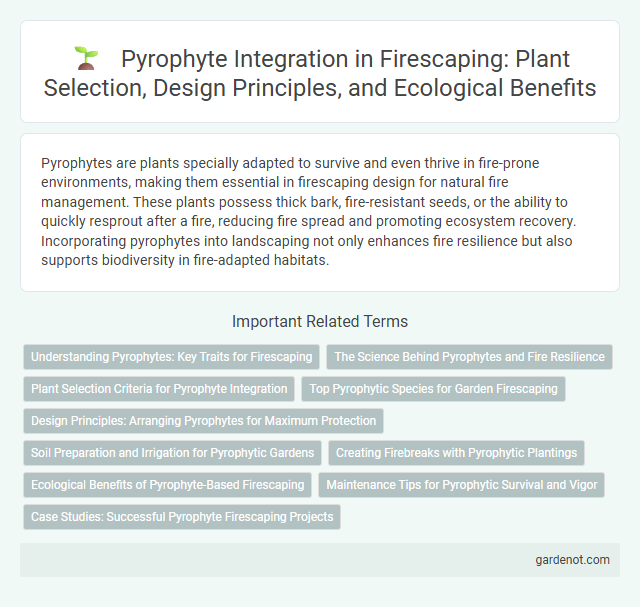Pyrophytes are plants specially adapted to survive and even thrive in fire-prone environments, making them essential in firescaping design for natural fire management. These plants possess thick bark, fire-resistant seeds, or the ability to quickly resprout after a fire, reducing fire spread and promoting ecosystem recovery. Incorporating pyrophytes into landscaping not only enhances fire resilience but also supports biodiversity in fire-adapted habitats.
Understanding Pyrophytes: Key Traits for Firescaping
Pyrophytes are plants adapted to survive and thrive in fire-prone environments, exhibiting traits such as thick bark, deep root systems, and the ability to resprout quickly after fire damage. These key characteristics make pyrophytes essential for firescaping, as they help create resilient landscapes that reduce wildfire risk and promote ecological recovery. Incorporating pyrophytes in firewise landscaping supports fire resistance while maintaining biodiversity and soil stability.
The Science Behind Pyrophytes and Fire Resilience
Pyrophytes possess specialized adaptations such as thick bark, resinous leaves, and epicormic buds that enable them to survive and regenerate after wildfire exposure. Their fire-resilient traits are a result of evolutionary pressure in fire-prone ecosystems, allowing rapid post-fire recovery and maintaining ecological balance. Scientific studies reveal that pyrophyte species actively contribute to fire regimes by influencing fuel loads and fire frequency, underscoring their critical role in natural fire ecology.
Plant Selection Criteria for Pyrophyte Integration
Pyrophyte integration in firescaping requires selecting plants with high fire resistance, thick bark, and low resin content to reduce flammability and withstand heat exposure. Species exhibiting rapid post-fire regeneration and deep root systems contribute to landscape resilience and soil stabilization. Prioritize drought-tolerant native pyrophytes that support local ecosystems and minimize irrigation needs for sustainable fire-adaptive landscaping.
Top Pyrophytic Species for Garden Firescaping
Top pyrophytic species for garden firescaping include manzanita (Arctostaphylos spp.), California lilac (Ceanothus spp.), and chamise (Adenostoma fasciculatum), all known for their fire-resistant properties and ability to recover quickly after wildfires. These plants contain low resin and oil content, reducing flammability while providing attractive foliage and seasonal blooms that enhance fire-adapted landscapes. Incorporating pyrophytes like these helps create defensible space and promotes ecological resilience in wildfire-prone garden environments.
Design Principles: Arranging Pyrophytes for Maximum Protection
Arranging pyrophytes strategically maximizes fire resistance by creating natural firebreaks and reducing fuel continuity around structures. Incorporate fire-adapted species with thick bark and high moisture content, spacing them to interrupt potential fire paths while maintaining aesthetic appeal. Proper layering of groundcovers, shrubs, and trees enhances protection by slowing fire spread and facilitating firefighting efforts.
Soil Preparation and Irrigation for Pyrophytic Gardens
Soil preparation for pyrophytic gardens requires well-draining, nutrient-poor soils mimicking native fire-prone habitats to support pyrophyte growth. Irrigation strategies emphasize minimal watering schedules to reduce fungal diseases and encourage deep root development critical for fire resilience. Incorporating organic mulch helps retain moisture while maintaining soil aeration, essential for pyrophytic plant health.
Creating Firebreaks with Pyrophytic Plantings
Pyrophytic plantings serve as effective firebreaks by utilizing fire-resistant species such as manzanita, ceanothus, and yarrow, which reduce flammable fuel loads and slow wildfire spread. Incorporating drought-tolerant and low-maintenance pyrophytes creates strategic barriers that enhance landscape resilience while minimizing irrigation needs. Proper spacing and arrangement of these fire-adapted plants optimize firebreak performance, protecting property and natural habitats in wildfire-prone areas.
Ecological Benefits of Pyrophyte-Based Firescaping
Pyrophytes, fire-adapted plants, enhance ecological resilience by promoting natural fire cycles that reduce fuel accumulation and support diverse habitats. Their presence in firescaping stabilizes soil, mitigates erosion, and fosters regeneration of native species, contributing to ecosystem balance. Utilizing pyrophytes leverages evolutionary fire adaptations, improving landscape recovery and biodiversity in fire-prone regions.
Maintenance Tips for Pyrophytic Survival and Vigor
Pyrophytes require minimal irrigation and benefit from occasional pruning to remove dead or damaged foliage, promoting robust growth and fire resistance. Maintaining well-drained soil enriched with organic matter supports root health and nutrient uptake essential for pyrophytic vigor. Regular monitoring for pests and diseases ensures early intervention, safeguarding the plants' natural defenses and long-term survival in fire-prone landscapes.
Case Studies: Successful Pyrophyte Firescaping Projects
Pyrophyte firescaping projects demonstrate exceptional resilience by incorporating fire-adapted plants like manzanita and ceanothus, significantly reducing wildfire spread and damage in California's chaparral ecosystems. Case studies reveal that integrating these pyrophytes in defensible space designs has decreased fuel loads while maintaining biodiversity and landscape aesthetics. Successful implementations in regions such as Santa Barbara and Mendocino highlight improved fire resistance and ecological restoration through strategic firescaping using native pyrophytic species.
Pyrophyte Infographic

 gardenot.com
gardenot.com